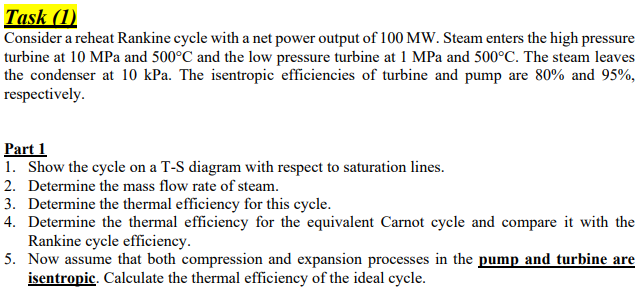Consider a reheat Rankine cycle with a net power output of 100 MW. Steam enters the high pressure turbine at 10 MPa and 500°C and the low pressure turbine at 1 MPa and 500°C. The steam leaves the condenser at 10 kPa. The isentropic efficiencies of turbine and pump are 80% and 95%, respectively. Part 1 1. Show the cycle on a T-S diagram with respect to saturation lines. 2. Determine the mass flow rate of steam. 3. Determine the thermal efficiency for this cycle.
Consider a reheat Rankine cycle with a net power output of 100 MW. Steam enters the high pressure turbine at 10 MPa and 500°C and the low pressure turbine at 1 MPa and 500°C. The steam leaves the condenser at 10 kPa. The isentropic efficiencies of turbine and pump are 80% and 95%, respectively. Part 1 1. Show the cycle on a T-S diagram with respect to saturation lines. 2. Determine the mass flow rate of steam. 3. Determine the thermal efficiency for this cycle.
Elements Of Electromagnetics
7th Edition
ISBN:9780190698614
Author:Sadiku, Matthew N. O.
Publisher:Sadiku, Matthew N. O.
ChapterMA: Math Assessment
Section: Chapter Questions
Problem 1.1MA
Related questions
Question

Transcribed Image Text:Task (1)
Consider a reheat Rankine cycle with a net power output of 100 MW. Steam enters the high pressure
turbine at 10 MPa and 500°C and the low pressure turbine at 1 MPa and 500°C. The steam leaves
the condenser at 10 kPa. The isentropic efficiencies of turbine and pump are 80% and 95%,
respectively.
Part 1
1. Show the cycle on a T-S diagram with respect to saturation lines.
2. Determine the mass flow rate of steam.
3. Determine the thermal efficiency for this cycle.
4. Determine the thermal efficiency for the equivalent Carnot cycle and compare it with the
Rankine cycle efficiency.
5. Now assume that both compression and expansion processes in the pump and turbine are
isentropic. Calculate the thermal efficiency of the ideal cycle.
Expert Solution
This question has been solved!
Explore an expertly crafted, step-by-step solution for a thorough understanding of key concepts.
Step by step
Solved in 4 steps with 1 images

Knowledge Booster
Learn more about
Need a deep-dive on the concept behind this application? Look no further. Learn more about this topic, mechanical-engineering and related others by exploring similar questions and additional content below.Recommended textbooks for you

Elements Of Electromagnetics
Mechanical Engineering
ISBN:
9780190698614
Author:
Sadiku, Matthew N. O.
Publisher:
Oxford University Press

Mechanics of Materials (10th Edition)
Mechanical Engineering
ISBN:
9780134319650
Author:
Russell C. Hibbeler
Publisher:
PEARSON

Thermodynamics: An Engineering Approach
Mechanical Engineering
ISBN:
9781259822674
Author:
Yunus A. Cengel Dr., Michael A. Boles
Publisher:
McGraw-Hill Education

Elements Of Electromagnetics
Mechanical Engineering
ISBN:
9780190698614
Author:
Sadiku, Matthew N. O.
Publisher:
Oxford University Press

Mechanics of Materials (10th Edition)
Mechanical Engineering
ISBN:
9780134319650
Author:
Russell C. Hibbeler
Publisher:
PEARSON

Thermodynamics: An Engineering Approach
Mechanical Engineering
ISBN:
9781259822674
Author:
Yunus A. Cengel Dr., Michael A. Boles
Publisher:
McGraw-Hill Education

Control Systems Engineering
Mechanical Engineering
ISBN:
9781118170519
Author:
Norman S. Nise
Publisher:
WILEY

Mechanics of Materials (MindTap Course List)
Mechanical Engineering
ISBN:
9781337093347
Author:
Barry J. Goodno, James M. Gere
Publisher:
Cengage Learning

Engineering Mechanics: Statics
Mechanical Engineering
ISBN:
9781118807330
Author:
James L. Meriam, L. G. Kraige, J. N. Bolton
Publisher:
WILEY